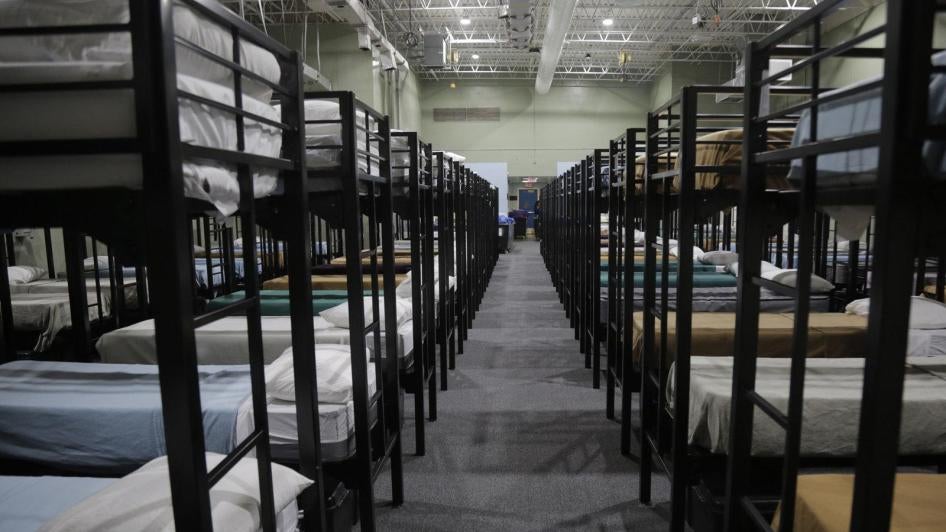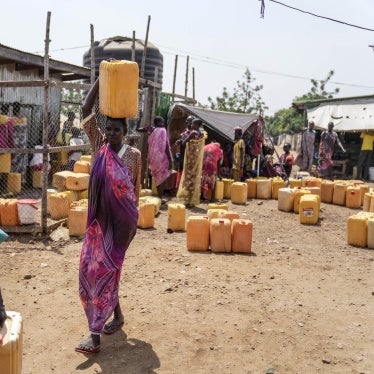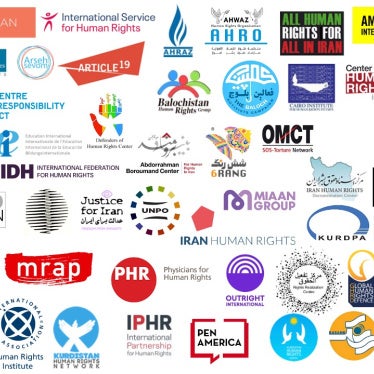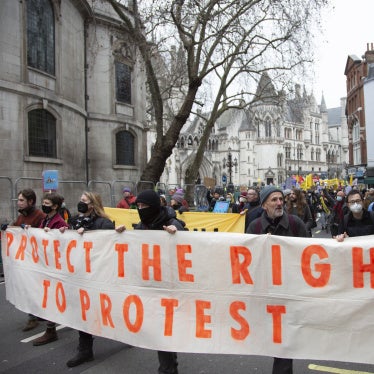The sounds of sobbing children, some struggling to breathe, outraged the public in June 2018 as the impact of the Trump administration’s forced family separation policy became widely known.[1]
The policy was striking for the deliberate way it inflicted harm on children in the name of deterrence. The authorities rolled it out along the US-Mexico border after a six-month pilot, fully aware of its adverse impact on families, and over the objections of federal prosecutors.[2]
But US authorities have long subjected arriving migrant children to abusive conditions and other trauma.[3] An ethos of enforcement at the expense of protection, opaque and often unreviewable administrative action, and ineffective preparation for the modern face of migration all contribute to the problem. A recent proposal for a high-level office for children could be part of the solution, if given adequate authority and independence.[4]
Irregular migration to the United States has been shifting significantly over the last few decades. Once primarily adult, usually male, and overwhelmingly from Mexico, the people crossing the southwestern US border are now often women travelling with children or on their own, unaccompanied children, and extended families. Many proactively seek out Border Patrol agents the moment they set foot on US soil.[5]
Migrant women and children are now often coming from El Salvador, Honduras, or Guatemala—and more recently, Nicaragua, Venezuela, or Haiti.[6] Safety is often their primary concern.[7] Climate change and violence can also be interrelated factors: in Honduras, for example, where repeated droughts linked to climate change have increased food insecurity, widespread violence prevents families from moving elsewhere in the country safely.[8]
US authorities struggled to care for children who arrived on their own well before the numbers of children arriving increased significantly.
In 1985, when the US Immigration and Naturalization Service detained 15-year-old Jenny Lisette Flores for two months, INS agents regularly strip-searched her and other girls. Some children shared bathrooms or even sleeping quarters with unrelated adults.[9]
The government settled the class action suit brought in her name after more than a decade of litigation, agreeing that children should be kept in safe and sanitary conditions and promptly transferred out of INS custody, preferably released to relatives living in the United States.[10] Attorneys and other experts were allowed regular inspections to assess compliance.[11] Under the Flores settlement, the government agreed to introduce, within four months, regulations that reflected these standards.[12]
Twenty years passed with no regulations, and then the Trump administration published rules that would have gutted the settlement.[13]
It’s hard to overstate the need for Flores protections. Legal action to enforce the agreement has addressed abuses in family detention centers, lengthy detention in “deplorable and unsanitary conditions” in Customs and Border Protection (CBP) holding cells, and the regular administration of psychotropic medication without parental consent or judicial authorization, among other violations.[14] The regular attorney inspections under the agreement (some of which the authors took part in) helped document conditions for thousands of children held in “large congregate care facilities” between 2017 and 2019, including a tent city in the desert, a repurposed WalMart, and an unused military base.[15]
One Flores inspection in which we participated found that senior CBP officials had instructed Border Patrol agents to hold children of all ages, some still in diapers, for weeks in increasingly overcrowded cells, a windowless warehouse, and a loading dock at a little-used border station near El Paso, Texas.[16] Our inspection was the same week in June 2019 that a government attorney told a panel of federal judges that the Flores requirement to hold children in “safe and sanitary” facilities did not necessarily include soap, toothbrushes, or the opportunity to sleep.[17] (The judges “emphatically disagree[d].”[18])
The federal courts enjoined many of the 2019 regulations from taking effect, and the Biden administration has said that it won’t seek to terminate Flores.[19] But there’s no guarantee that future rulemaking will preserve all of the Flores protections, particularly the regular attorney inspections—in practical terms, the only source of independent investigation of children’s rights violations in immigration detention.
To be sure, the Departments of Homeland Security, Justice, and Health and Human Services have internal investigators. The Government Accountability Office has also uncovered serious shortcomings in immigration detention, including with respect to family separation.[20]
But the GAO doesn’t have a civil rights mandate. The other entities aren’t in principle influenced by the agencies they examine, but they are no substitute for truly independent monitoring.
An enterprising US attorney could take these issues on, but we haven’t seen that happen.
An independent federal children’s ombuds office could help fill the accountability gap, if it’s given the authority to investigate violations of children’s rights by all federal agencies, including CBP, Immigration and Customs Enforcement, and their contractors.
In addition, while it would lack independence, a cabinet-level post, such as a Secretary for Children, could help ensure that all policies involving children—including immigration policies—proactively and intentionally incorporate children’s rights.
The needs of migrant children have too often been overlooked—and at times callously disregarded—in federal policies and the practices of US immigration agencies. Strong safeguards for children’s rights—such as a federal children ombuds and a Secretary for Children—are badly needed.
Michael Garcia Bochenek is senior counsel to the Children’s Rights Division of Human Rights Watch and an adjunct associate professor at the Institute for Human Rights at Columbia University. bochenm@hrw.org.
Warren Binford is Professor of Pediatrics, Professor of Law, and the W.H. Lea Endowed Chair for Justice in Pediatric Law Policy & Ethics at the University of Colorado. warren.binford@cuanschutz.edu.
[1] G. Thompson, “Listen to children who’ve just been separated from their parents at the border,” ProPublica (June 18, 2018). Available at https://www.propublica.org/article/children-separated-from-parents-border-patrol-cbp-trump-immigration-policy.
[2] See M. D. Shear, K. Benner, and M. S. Schmidt, “‘We need to take away children,’ no matter how young, Justice Dept. officials said,” New York Times (October 6, 2020, updated October 28, 2021). Available at https://www.nytimes.com/2020/10/06/us/politics/family-separation-border-immigration-jeff-sessions-rod-rosenstein.html.
[3] See, e.g., Human Rights Watch, Slipping through the cracks: Unaccompanied children detained by the US Immigration and Naturalization Service (New York: Human Rights Watch, 1997); Human Rights Watch, In the freezer: Abusive conditions for women and children in US immigration holding cells (New York: Human Rights Watch, 2018).
[4] See M. Abaya, N. Bajaj, W. Barren, et al., “US high-level office for children is critical for children’s rights,” Health and Human Rights Journal (March 10, 2022). Available at https://www.hhrjournal.org/2022/03/us-high-level-office-for-children-is-critical-for-childrens-rights/.
[5] See, e.g., M. Greenberg, “Hampered by the pandemic: Unaccompanied child arrivals increase as earlier preparedness shortfalls limit the response,” Migration Policy Institute (March 2021). Available at https://www.migrationpolicy.org/news/unaccompanied-child-arrivals-earlier-preparedness-shortfalls; M. Chishti, S. Pierce, and H. Telus, “Spike in unaccompanied child arrivals at US-Mexico border proves enduring challenge,” Migration Policy Institute (June 27, 2019). Available at https://www.migrationpolicy.org/article/spike-unaccompanied-child-arrivals-proves-enduring-challenge.
[6] J. Gramlisch and A. Scheller, “What’s happening at the US-Mexico border in 7 charts,” Pew Research Center (November 9, 2021). Available at https://www.pewresearch.org/fact-tank/2021/11/09/whats-happening-at-the-u-s-mexico-border-in-7-charts/.
[7] UNHCR and UNICEF, Families on the run: Why families flee from northern and central America (Geneva: UNHCR, 2021). Available at https://familiesontherun.org/.
[8] S. Bermeo and D. LeBlang, Honduras migration: Climate change, violence, and assistance (March 2021). Available at https://dcid.sanford.duke.edu/wp-content/uploads/sites/7/2021/03/Honduras-Migration-Policy-Brief-Final.pdf.
[9] Flores by Galvez-Maldonado v. Meese, 934 F.2d 1991, 1014 (9th Cir. 1990) (Fletcher, C.J., dissenting); L.R. Navarro, “An analysis of treatment of unaccompanied immigrant and refugee children in INS detention and other forms of institutionalized cruelty,” Chicana/o Latina/o Law Review 19/1 (1998), pp. 596-97.
[10] Flores v. Reno, Stipulated Settlement Agreement, ¶¶ 11, 12.A, 14, No. CV 85-4544-RJK(Px) (C.D. Cal. Jan. 17, 1997).
[11] Ibid., ¶¶ 32-33.
[12] Ibid., ¶ 9.
[13] Processing, Care, and Custody of Alien Minors and Unaccompanied Alien Children, 83 Fed. Reg. 45,486 (Sept. 7, 2018), final rule published at 84 Fed. Reg. 44,392 (Aug. 23, 2019).
[14] Flores v. Johnson, Order, No. CV 85-4544 DMB (AGRx) (C.D. Cal. July 24, 2015)., aff’d in part, rev’d in part & remanded sub nom. Flores v. Lynch, 828 F.3d 898 (9th Cir. 2016); Flores v. Sessions, Order, No. CV 85-4544 DMB (AGRx) (C.D. Cal. June 27, 2017); Flores v. Sessions, Order, No. CV 85-4544 DMB (AGRx) (C.D. Cal. July 30, 2018).
[15] See, e.g., T. Misra, “A tent city in Tornillo, Texas, housed thousands of migrant children. Now it’s almost gone,” Pacific Standard (January 23, 2019). Available at https://psmag.com/social-justice/a-tent-city-in-texas-is-seeing-its-final-days; M. E. Miller, E. Brown, and A. C. Davis, “Inside casa padre, the converted Walmart where the U.S. is holding nearly 1,500 immigrant children,” Washington Post (June 14, 2018). Available at https://www.washingtonpost.com/local/inside-casa-padre-the-converted-walmart-where-the-us-is-holding-nearly-1500-immigrant-children/2018/06/14/0cd65ce4-6eba-11e8-bd50-b80389a4e569_story.html; J. Burnett, “Inside the largest and most controversial shelter for migrant children in the U.S.,” NPR News (February 13, 2019). Available at https://www.npr.org/2019/02/13/694138106/inside-the-largest-and-most-controversial-shelter-for-migrant-children-in-the-u-.
[16] S. Romero, Z. Kanno-Youngs, M. Fernandez, et al., “Hungry, scared and sick: Inside the migrant detention center in Clint, Tex.,” New York Times (June 9, 2019). Available at https://www.nytimes.com/interactive/2019/07/06/us/migrants-border-patrol-clint.html.
[17] H. Christophi, “Feds tell 9th Circuit: Detained kids ‘safe and sanitary’ without soap,” Courthouse News Service (June 18, 2019). Available at https://www.courthousenews.com/feds-tell-9th-circuit-detained-kids-safe-and-sanitary-without-soap/.
[18] Flores v. Barr, No. 17-56297, at *12 (9th Cir. Aug. 15, 2019).
[19] Flores v. Barr, Order, No. CV 85-4544 DMB (AGRx) (C.D. Cal. Sept. 27, 2019), aff’d sub nom. Flores v. Rosen, 984 F.3d 720 (9th Cir. 2020); C. Montoya-Galvez, “Biden administration discards Trump-era plan to end legal agreement protecting migrant children,” CBS News (December 11, 2021). Available at https://www.cbsnews.com/news/biden-administration-discards-trump-era-plan-to-end-legal-agreement-protecting-migrant-children/.
[20] A. Flores and H. Aleaziz, “US agencies made it harder to reunite immigrant families because they failed to keep accurate records, report finds,” Buzzfeed News (March 18, 2020). Available at https://www.buzzfeednews.com/article/adolfoflores/separated-immigrant-families-records-gao-report.










